- Register / Login
A password will be e-mailed to you

Reset Password

CALIBER 40 LRC
More information, image gallery, floor plans.
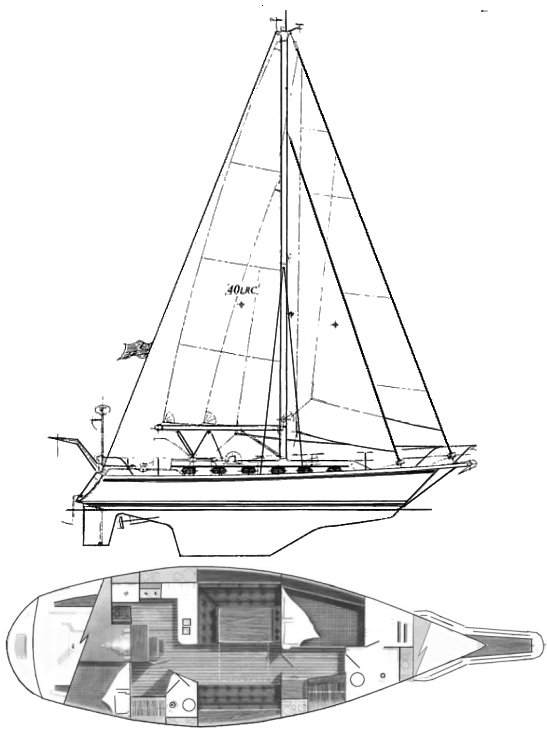
Use the form below to contact us!
- Types of Sailboats
- Parts of a Sailboat
- Cruising Boats
- Small Sailboats
- Design Basics
- Sailboats under 30'
- Sailboats 30'-35
- Sailboats 35'-40'
- Sailboats 40'-45'
- Sailboats 45'-50'
- Sailboats 50'-55'
- Sailboats over 55'
- Masts & Spars
- Knots, Bends & Hitches
- The 12v Energy Equation
- Electronics & Instrumentation
- Build Your Own Boat
- Buying a Used Boat
- Choosing Accessories
- Living on a Boat
- Cruising Offshore
- Sailing in the Caribbean
- Anchoring Skills
- Sailing Authors & Their Writings
- Mary's Journal
- Nautical Terms
- Cruising Sailboats for Sale
- List your Boat for Sale Here!
- Used Sailing Equipment for Sale
- Sell Your Unwanted Gear
- Sailing eBooks: Download them here!
- Your Sailboats
- Your Sailing Stories
- Your Fishing Stories
- Advertising
- What's New?
- Chartering a Sailboat
- Cruising Yachts 45' to 50'
- Caliber 40 LRC
The Caliber 40 LRC Sailboat Specs & Key Performance Indicators
The Caliber 40 LRC, a robust long-range cruiser sailboat, is a creation from the drawing board of Michael McCreary, an American designer. This sailboat exemplifies a blend of endurance and comfort for long-distance sailing.
It is built by Caliber Yachts, a company established and located in Clearwater, Florida. Caliber Yachts is renowned for its commitment to quality and durability, focusing on crafting vessels that cater to serious cruisers.
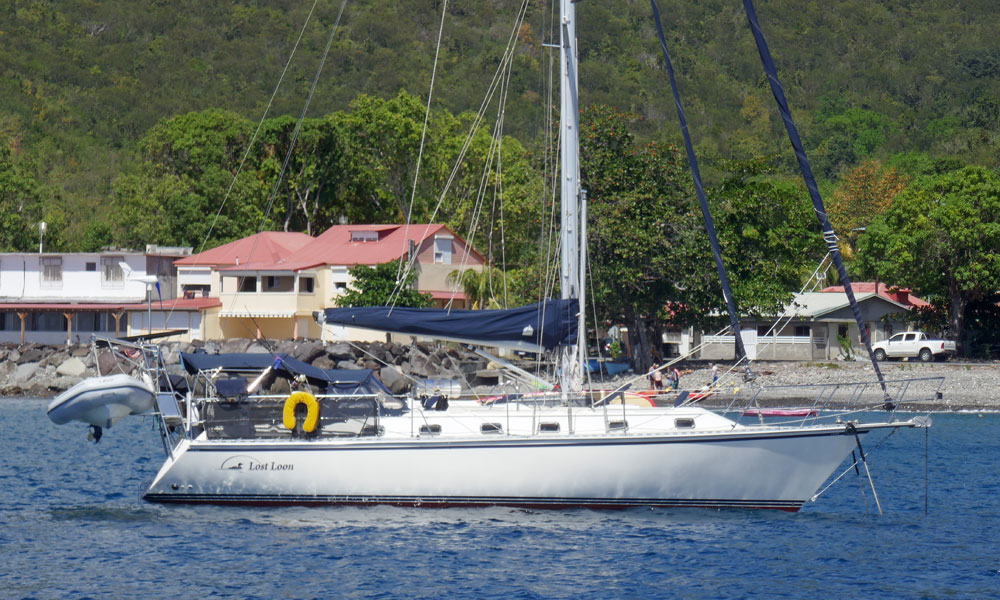
Brothers George and Michael McCreary, together with Marshall Jones, formed Caliber Yachts Inc. as a backyard boatbuilding company in 1979. Without bank financing, Caliber Yachts began building boats one at a time, producing its first, a 28-footer, in 1981. By 1985 the company was sufficiently solvent to build a factory, and introduce a 33-footer. A 30, 35, 40, and 47 followed. The Long Range Cruising (LRC) line began in 1994. The Caliber 40 LRC has a projected cruising range of 1,484 miles when motoring at 7 knots with a Yanmar 50 diesel running at 2,500 rpm.
Published Specification for the Caliber 40 LRC
Underwater Profile: Fin keel with skeg-hung rudder
Hull Material: GRP
Length Overall: 40'11" (12.5m)
Waterline Length: 32'6" (9.9m)
Beam: 12'8" (3.9m)
Draft: 5'0" (1.5m)
Rig Type: Cutter
Displacement: 21,600lb (9,798kg)
Designer: Michael McCreary
Builder: Caliber Yachts (USA)
Year First Built: 1995
Published Design Ratios for the Caliber 40 LRC
The Caliber 40 LRC sailboat, with its design ratios, offers a unique set of sailing characteristics ideal for long-term cruising.
- The Sail Area/Displacement Ratio of 15.3 suggests that while it might not be the fastest vessel, its performance is balanced, tailored more towards steady and reliable cruising rather than speed. This is slightly underpowered compared to high-performance boats but is typical for sturdy cruising designs prioritizing safety and comfort over racing capabilities.
- The Ballast/Displacement Ratio of 44 indicates a strong ability to resist capsizing and maintain stability in heavy winds. This high ratio points to a stiffer, more powerful vessel. However, it's crucial to remember that this metric doesn't account for the exact placement of ballast, which can significantly affect stability.
- With a Displacement/Length Ratio of 281 , the Caliber 40 LRC falls into the 'Heavy Displacement' category, which means it's designed to handle more adverse sea conditions robustly, albeit at the expense of requiring more sail area to reach its designed hull speed.
- A Comfort Ratio of 32.4 places this boat squarely within the range typical for moderate bluewater cruising boats. This indicates a vessel that should provide a relatively comfortable ride in various conditions, mitigating the excessive motion that can fatigue crew members during extended passages.
Moreover, the Capsize Screening Formula at 1.8 strongly underscores the boat's suitability for ocean passages, suggesting it has a lower propensity for capsizing compared to many other vessels, a critical factor for serious bluewater cruisers.
It's important to note the theoretical nature of these design ratios. While they provide valuable insights, they are general indicators and can't entirely capture all nuances of a boat's performance and comfort. Specifically, the Ballast/Displacement Ratio does not consider the vertical center of gravity, which is crucial for actual stability, and Ted Brewer's Comfort Ratio may not favor modern vessel designs that are beamy and light but still capable in heavy seas. Thus, while these ratios provide a useful framework for evaluating vessel traits, they should be considered in conjunction with real-world performance and sea trials.
More about Design Ratios...
The above text was drafted by sailboat-cruising.com using GPT-4 (OpenAI’s large-scale language-generation model) as a research assistant to develop source material; we believe it to be accurate to the best of our knowledge.
Press Reviews for the Caliber 40 LRC
Practical Sailor tells us "The design and construction of the Caliber 40 LRC make it suitable for offshore use. In decent winds it should give 150-180-mile days. Upwind performance is typical of moderately heavy cruising boats; odds are she’ll be motor-sailed on long coastal trips to weather. On balance, she’ll cover fewer miles than lighter-weight competitors, but will provide a more comfortable ride in heavy seas. Read more...
Other sailboats in the Caliber range include:
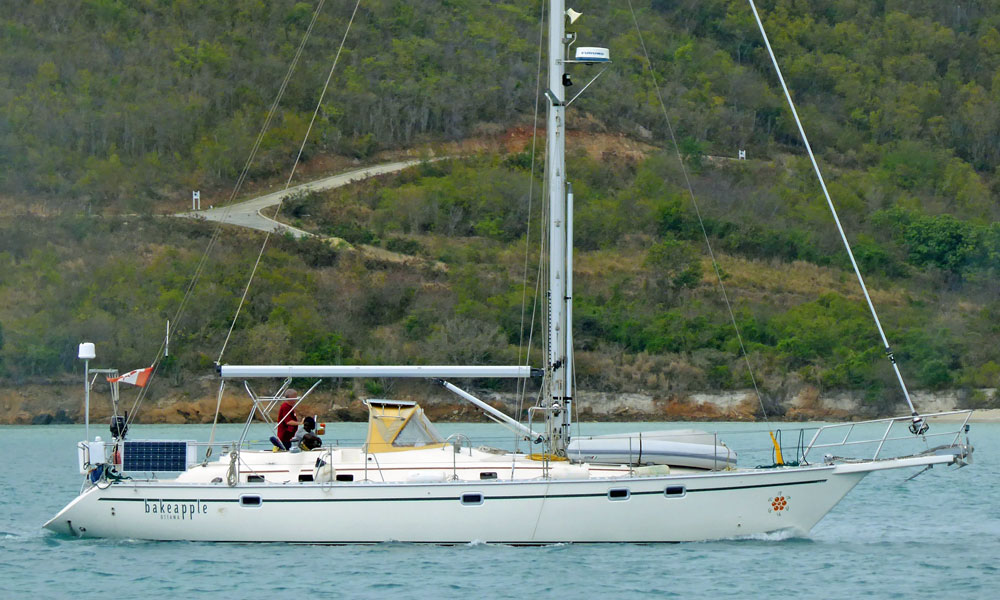
Recent Articles
Apla 42 Sailboat Specs & Key Performance Indicators
Aug 30, 24 02:51 AM
Ovni 445 Sailboat Specs & Key Performance Indicators
Aug 29, 24 03:44 AM
Catalina 34 Sailboat Specs & Key Performance Indicators
Aug 29, 24 12:14 AM
Here's where to:
- Find Used Sailboats for Sale...
- Find Used Sailing Gear for Sale...
- List your Sailboat for Sale...
- List your Used Sailing Gear...
Our eBooks...

A few of our Most Popular Pages...

Copyright © 2024 Dick McClary Sailboat-Cruising.com
- New Sailboats
- Sailboats 21-30ft
- Sailboats 31-35ft
- Sailboats 36-40ft
- Sailboats Over 40ft
- Sailboats Under 21feet
- used_sailboats
- Apps and Computer Programs
- Communications
- Fishfinders
- Handheld Electronics
- Plotters MFDS Rradar
- Wind, Speed & Depth Instruments
- Anchoring Mooring
- Running Rigging
- Sails Canvas
- Standing Rigging
- Diesel Engines
- Off Grid Energy
- Cleaning Waxing
- DIY Projects
- Repair, Tools & Materials
- Spare Parts
- Tools & Gadgets
- Cabin Comfort
- Ventilation
- Footwear Apparel
- Foul Weather Gear
- Mailport & PS Advisor
- Inside Practical Sailor Blog
- Activate My Web Access
- Reset Password
- Customer Service

- Free Newsletter

Ericson 41 Used Boat Review

Mason 33 Used Boat Review

Beneteau 311, Catalina 310 and Hunter 326 Used Boat Comparison

Maine Cat 41 Used Boat Review

Tips From A First “Sail” on the ICW

Tillerpilot Tips and Safety Cautions

Best Crimpers and Strippers for Fixing Marine Electrical Connectors

Thinking Through a Solar Power Installation

Getting the Most Out of Older Sails

How (Not) to Tie Your Boat to a Dock

Stopping Mainsheet Twist

Working with High-Tech Ropes

Fuel Lift Pump: Easy DIY Diesel Fuel System Diagnostic and Repair

Ensuring Safe Shorepower

Sinking? Check Your Stuffing Box

The Rain Catcher’s Guide

Boat Repairs for the Technically Illiterate

Boat Maintenance for the Technically Illiterate: Part 1

Whats the Best Way to Restore Clear Plastic Windows?

Mastering Precision Drilling: How to Use Drill Guides

Giving Bugs the Big Goodbye

Galley Gadgets for the Cruising Sailor

Those Extras you Don’t Need But Love to Have

UV Clothing: Is It Worth the Hype?

Preparing Yourself for Solo Sailing


How to Select Crew for a Passage or Delivery

Preparing A Boat to Sail Solo

On Watch: This 60-Year-Old Hinckley Pilot 35 is Also a Working…

On Watch: America’s Cup

On Watch: All Eyes on Europe Sail Racing

Dear Readers

Chafe Protection for Dock Lines
- Sailboat Reviews
Though now an old and dated design, the Cal 40 was a hot boat when new, and she carries that legacy.
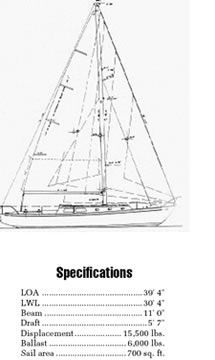
Thunderbird, a Cal 40 owned by IBM president T. Vincent Learson, took first in fleet over 167 boats in the 1966 Bermuda Race. Because this was the first computer-scored Bermuda Race, Learson got a lot of gaff about the IBM computer that had declared him the winner—and about beating out his boss. Thomas J. Watson, IBM’s chairman of the board, sailed his 58′ cutter, Palawan, second across the line, but ended with second in class, 24th in fleet, on corrected time.
In fact, the computer scoring system was not especially kind to Learson. Both he and Watson would have fared considerably better under the old system that calculated scores from the NAYRU time allowance tables. Thunderbird’s victory was a legitimate win, another in a stunning series by Cal 40s that was establishing the boat as a revolutionary design. The first Cal 40 was built for George Griffith in 1963. That winter, hull #2, Conquistador, took overall honors in the 1964 Southern Ocean Racing Circuit (SORC). The Transpac races of 1965, ’66, and ’67 all went to Cal 40s. Ted Turner’s Cal 40, Vamp X, took first place in the 1966 SORC. In the ’66 Bermuda Race, five of Thunderbird’s sisterships finished with her in the top 20 in fleet, taking five of the first 15, four of the first nine places. And so on. In their first few years on the water, Cal 40s chalked up an astonishing record.
The 40 was the fifth in a line of Cal designs that C. William Lapworth did for Jensen Marine of Costa Mesa, California. Lapworth had already designed a series of moderately successful racing boats, the L classes, including an L-24, L-36, L-40 and L-50, when he teamed up with Jack Jensen. The Cal designs were built on concepts he had tried in his Lclass boats. The first Cal was the 24, Jensen’s first boat, launched in 1959. The Lapworth-Jensen team then produced a 20, 30, and 28 before getting to the Cal 40, which proved to be a successful distillation of Lapworth’s thinking up to that time.
Aspects of the boat that departed from the conventional wisdom were her light displacement, long waterline, flat bilges to encourage surfing, fin keel and spade rudder. The masthead rig is stayed by shrouds secured to chainplates set inboard of the toerail, a then unusual innovation that allows a reduced sheeting angle. The success of the design helped legitimize fiberglass as a hull material, establish Jensen Marine as a significant builder of fiberglass boats, and propel Lapworth to the forefront of yacht design.
Three decades have passed since Lapworth drew the Cal 40. In that time, using computers to score races has become commonplace—boat measurers and designers would be paralyzed without them. The CCA Rule, the NAYRU tables and the Portsmouth Yardstick have been replaced by IMS, IOR, and PHRF, with the effects of their parameters expressed in the shape, size and weight of new boats. New building materials and techniques have changed the meaning of terms such as “light displacement,” “long waterline,” “fin keel,” and “fast sailboat.” Today the Cal 40 is a dated design, having been surpassed in her revolutionary features by her descendents. She remains among the esteemed elite of racing yachts, but she is not especially light, long on the waterline, or fast compared to current designs.
The Cal’s builder was transformed by time, as well. Jensen Marine was bought by Bangor Punta Marine, and the Cal production line was moved to Florida about the time that the Cal 40 went out of production in 1972. For the next decade, the company’s name and address shifted between combinations of Cal, Bangor Punta and Jensen in California, New Jersey and finally Massachusetts, where it joined O’Day under Bangor Punta’s umbrella in the early 1980s. After 1984 the company was called Lear Siegler Marine, Starcraft Sailboat Products, and finally emerged as Cal, a Division of the O’Day Corporation, in Fall River, Mass. Cal and O’Day ceased production in April, 1989.
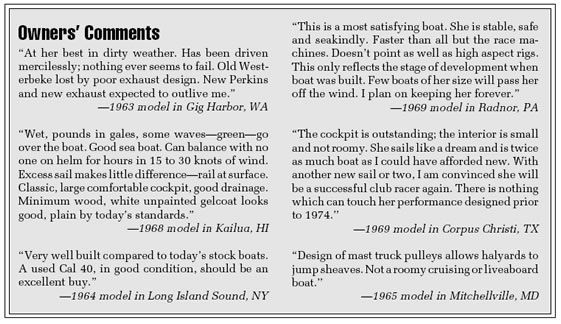
Construction The construction of the Cal 40 is typical of Jensen Marine boats of the 1960s. The hull is solid hand laid fiberglass with wooden bulkheads and interior structures. Strips of fiberglass cloth and resin secure the wooden structures to the hull, but this tabbing is rather lightweight and has been reinforced in some Cal 40s where it has failed. If it has not been reinforced, it probably needs it.
Because saving weight was a priority in building the Cal 40, the reinforcement provided by the bulkheads and furniture is critical to hull stiffness. Failure of the bonding can be a significant structural concern.
The hull-to-deck joint is an inward-turning hull flange, upon which the deck molding is bonded, then through-bolted and capped with a throughbolted teak toerail. This is a strong type of joint, but there is some complaint of minor leaking along it in a few boats. The leaks are most likely one result of the relatively light construction of the hull skin, which has a tendency to “oilcan” in heavy weather, creating stresses at the joint.
The deck, also a solid fiberglass layup, has reinforcement designed into it during layup, so no interior metal backing plates are provided under winches, cleats, and other hardware. PS generally recommends backing plates behind high-stress hardware as a matter of course. We found little indication of trouble with leaking or working of most of the fittings, but one owner said that his lifeline stanchion bases had to be reinforced. This would be an area to inspect carefully.
Colors and non-skid surfaces are molded in, but due to the age of any Cal 40, the finish will look tired unless it has been renewed. A good Awlgrip job will do it wonders, and is probably warranted for this boat unless it is in general disrepair.
The deck and cockpit of the Cal 40 we inspected have numerous cracks in the gelcoat in corners and other stress areas. Check these areas closely—they are unsightly, but in most cases are not a structural concern.
Ballast is an internal lead casting dropped into the keel before the insides were assembled. If there is evidence that the boat has suffered a hard grounding, invesitgate the ballast cavity to see that it was properly repaired. It should not have a hollow sound when rapped, and there should be no cracks, weeping, or other evidence of moisture inside. Due to the construction sequence, major repairs could be awkward.
Wiring was also installed prior to the interior, which makes it quite inaccessible in some areas. What may be of more concern is that it is low enough in the boat to get wet if the last watch forgot to pump the bilges and the boat heels over to her work. That’s what happened to one owner, who lost all the electricity on the boat when approaching Nova Scotia’s Bras d’Or Lakes after an all night sail. Fortunately, dawn arrived in time to avert a navigation problem. They anchored in the harbor and found that the electrical system worked fine, once it got dry again. Before the next season rolled around, the boat’s entire electrical system had been replaced in elevated, accessible locations. The implication is that you should look carefully at the wiring in a Cal 40 before you make any decisions. If it has been replaced, try to learn who did the work and how well qualified he/she was for the job. If it has not, you may have to work the cost of rewiring into your acquisition expenses. We would suspect the worst until proven otherwise.
You might expect wheel steering on a boat this size, but the stock Cal 40 came with a big tiller. The boat is well enough balanced to be controlled with a tiller, and many helmsmen prefer it to a wheel, which masks feedback from the rudder and makes sensitive steering more difficult.
The cockpit is roomy, but properly designed for offshore work with relatively low volume, a bridgedeck and small companionway. The tiller sweeps the cockpit midsection, allowing the helmsman to sit fairly far forward, a help to visibility.
Winch islands are located aft of the helmsman, where there is room for the crew, but it also makes the sheets accessible to the helmsman for shorthanded sailing. The teak cockpit coaming has cutouts giving access to handy storage bins.
The aluminum mast is stepped through the deck to a fitting that meets it at the level of the cabin sole. The shroud chainplates are secured to a transverse bulkhead at the mast station, and then tied into an aluminum weldment in the bilges. This weldment also supports the mast step. While chainplates have been an area of concern in some designs, because they can work under the large loads they carry, our indications from Cal 40 owners are that the chainplate/shroud/mast step attachments have served well.

Sailing Performance The Cal 40 is in her element in heavy air, especially off the wind. Her long waterline and flat bilges help her get up and go on reaches and runs, surfing in heavy air. On the wind, the flat hull forward pounds in waves and chop, which slows the boat somewhat and is irritating. Owners agree that she sails best with the rail in the water. She is not dry on the wind, so a dodger is a welcome feature.
The masthead sailplan allows relatively easy reduction of headsails to suit heavier conditions, and Cal 40 owners extol the survivability of their boats. “Simple rig, nothing breaks, strong, easy to use,” is a typical comment. Despite her stellar racing record, the Cal 40 is only ordinary in performance by today’s standards. She carries a PHRF rating between 108 and 120 seconds per mile, depending on the region. That’s about the same as a C&C 38 or an Ericson 36, both IOR designs of the late 70s. Compared to a mid-1970s design such as the Swan 38, the Cal 40 is a bit slower on the wind and in light air, a bit faster off the wind and in heavier going, about equal in speed overall. It’s not surprising that these boats perform alike if you look at the length of their waterlines and their displacements.
In comparing the Cal 40 to boats of her own vintage one sees what all the fuss was about. The Columbia 40, for example, is a 1965 Charles Morgan design, an “all-out racer” with a 27′ waterline, displacement of 20,200 pounds, and a PHRF rating of about 170. Or look at the Hinckley 41: 29′ on the water, 18,500 pounds, PHRF about 160.
The Cal 40’s waterline is almost 31′, but she displaces one or two tons less than the Columbia or the Hinckley, and rates nearly one minute per mile faster under PHRF. In that context, she is indeed a fast, light displacement boat with a long waterline. Just look at her “fin keel” and you can see the progression. Compared to a full keel with attached rudder, it is small. Compared to a modern fin keel, it hardly seems small enough to qualify for the name. If Cal 40s win races today, it’s because they are well sailed, not because the boat is the fast machine on the race course.
Interior In the 60s, “accommodations” tended to imply the number of berths in a sailboat, and the more the better. It also included the notion of a basic galley with sink, stove, icebox, and a table of sorts, plus a head with toilet and sink. Space age electronics had not arrived in the galley or the nav station, nor had space arrived in the concept of the main saloon.
Inside, as elsewhere, the Cal 40 is well designed and functional, but she speaks of her own era. The layout is very traditional, with a V-berth forward, separated from the main cabin by a head and hanging locker. Pilot berths and extension settees port and starboard provide sleeping for four. The dropleaf table seats four, six if you squeeze. Next aft is the galley to port and a nav station to starboard, consisting of a chart table over the voluminous icebox. The galley has a usable sink next to the well for a gimbaled stove with oven.
Flanking the companionway steps are the entrances to the quarterberths, known affectionately as “torpedo tubes,” which gives you an impression of their dimensions. They extend from the main cabin through to the lazarette, which allows good circulation of air. In fact, on a return trip from Bermuda, one seasick sailor found great solace between tricks at the helm by climbing into one of the cocoon-like torpedo tubes, where he was washed with a fresh breeze from the dorade vent on the lazarette cover. The fact that the quarterberths flank the engine compartment doesn’t matter as long as you are under sail, but it’s a different story when under power.
So you have sleeping accommodations for eight, which is too many people on a 40-footer, except perhaps when racing. The extension transom berths, however, do not lend themselves to use under way. The interior, not spacious by modern standards, fills up fast with extra bodies aboard. Owners tend to convert some of the berths to storage space. The pilot berths are especially tempting for that use, but since they are also the most comfortable berths on the boat, the quarterberths are often sacrificed for storage.
One of the best features about the Cal 40’s interior is the dining table. Set slightly to port, it is supported by a sturdy sole-to-overhead stainless steel post at each end with a 4′ 4″ gimbaled mahogany tray between them above the table. The posts make excellent handholds, and the gimbaled tray can serve for everything from salt and pepper holder to bookshelf to diaper-changing table. The table has a drop leaf to port and to starboard, so it can be set up for use from the port settee without blocking fore-and-aft passage through the boat.
Engine A variety of powerplants will be found in Cal 40s. Some early hulls were equipped with Atomic 4 gasoline engines. Later hulls got Graymarine 4-112 gasoline or Perkins 4-107 diesels. It’s likely that the original engine will need to be replaced if it has not already been done. Even the newest Cal 40s are rather old, and the early models have passed the quarter-century mark.
Boats in our files have Volvo MD2B, the Perkins, Pathfinder 50, Westerbeke 4-108, and Pisces 40 from Isuzu listed as replacements for the original engine.
The engine is located under the cockpit, between the torpedo tubes, which allow access to both sides, but are not especially convenient, particularly if the area has been turned into storage space. Better is the companionway ladder, which removes to expose the front of the engine. That can be an inconvenience, too, if the engine needs some attention while under way.
Used for the minimum requirements of a racing yacht, primarily getting in and out of port, you can probably make do with any of the engines. If the boat is to be used for cruising, with greater demands to be made on the engine, the Atomic 4 would likely be inadequate.
Generally the boat will do about six or seven knots under power, depending on the power plant and propeller. We suspect that many Cal 40s will have folding propellers, good for racing but not the best for powering, especially in reverse. The spade rudder set well aft confers good maneuverability under most conditons.
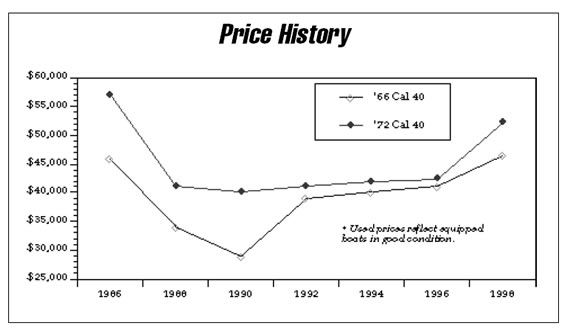
Conclusions The Cal 40, a hot racing boat when new, carries that legacy with her into maturity. Generally, the boats have been raced hard, some cruised hard as well.Owners have tended to be the type to add gear and modifications to keep the boat comfortable and competitive. The boats are likely to have a large inventory of much-used sails.
Because of her age and dated design, a Cal 40 may be available for much less money than a newer boat offering comparable quality and performance. Prices will vary according to the condition of the boat and gear, but will likely fall in the range of $40,000 to $50,000. If the boat has lots of add-ons in the galley and nav station, modern racing hardware, renewed standing rigging, new finish on the topsides, and the bottom is in good condition, it might fetch something higher. One performance extra to look for is a special (non-factory) fairing job on the keel and rudder that was available when the boats were young.
On the other hand, it should not be a surprise if there are areas that require attention, and you should calculate the cost of the work into the price you are willing to pay. Twenty or 25 years of hard sailing will take its toll. Significan’t expense could be incurred if the boat needs new wiring, an Awlgrip job on the topsides, extensive reinforcement of the interior furniture tabbing, a new engine, or new rigging. If racing is in your plans, new sails might be scheduled in as well.
This would be a good boat for a handy do-ityourselfer. Over the years, most of the boat’s problems have been solved more than once by other Cal 40 owners, many willing to share their wisdom. You would probably have a choice of solutions, and indications of which worked best.
Although there is not currently an active owners association, there persists a loose fellowship among present and former owners. If you buy a Cal 40, you will acquire a modest boat, with good pedigree and performance, and—should you desire them—a few new friends, as well.
RELATED ARTICLES MORE FROM AUTHOR
Leave a reply cancel reply.
Log in to leave a comment
Latest Videos

What’s the Best Sailboats for Beginners?

Why Does A Sailboat Keel Fall Off?

The Perfect Family Sailboat! Hunter 27-2 – Boat Review

Pettit EZ-Poxy – How to Paint a Boat
Latest sailboat review.
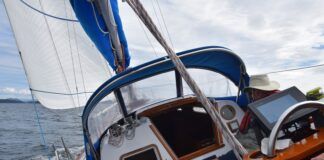
- Privacy Policy
- Do Not Sell My Personal Information
- Online Account Activation
- Privacy Manager
Caliber 40 lrc
The caliber 40 lrc is a 40.92ft cutter designed by michael mccreary and built in fiberglass by caliber yachts (usa) since 1995..
The Caliber 40 lrc is a moderate weight sailboat which is slightly under powered. It is very stable / stiff and has a good righting capability if capsized. It is best suited as a bluewater cruising boat. The fuel capacity is excellent. There is a good water supply range.
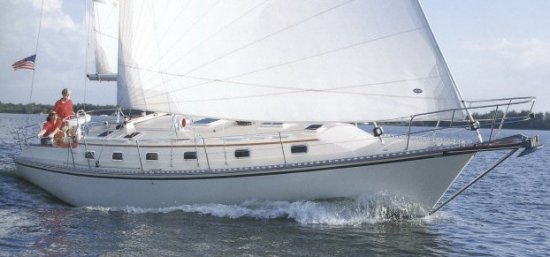
Caliber 40 lrc for sale elsewhere on the web:

Full tour of this Caliber 40 lrc for sale by Learning the Lines

Main features
| Model | Caliber 40 lrc | ||
| Length | 40.92 ft | ||
| Beam | 12.67 ft | ||
| Draft | 5.08 ft | ||
| Country | United states (North America) | ||
| Estimated price | $ 150000 |
Login or register to personnalize this screen.
You will be able to pin external links of your choice.

Is this world cruiser right for us ? Youtube

See how Sailboatlab works in video
| Sail area / displ. | 15.30 | ||
| Ballast / displ. | 43.98 % | ||
| Displ. / length | 280.90 | ||
| Comfort ratio | 32.39 | ||
| Capsize | 1.82 |
| Hull type | Monohull fin keel with rudder on skeg | ||
| Construction | Fiberglass | ||
| Waterline length | 32.50 ft | ||
| Maximum draft | 5.08 ft | ||
| Displacement | 21600 lbs | ||
| Ballast | 9500 lbs | ||
| Hull speed | 7.64 knots |

We help you build your own hydraulic steering system - Lecomble & Schmitt
| Rigging | Cutter | ||
| Sail area (100%) | 739 sq.ft | ||
| Air draft | 0 ft | ?? | |
| Sail area fore | 435.56 sq.ft | ||
| Sail area main | 303.09 sq.ft | ||
| I | 50.50 ft | ||
| J | 17.25 ft | ||
| P | 45.75 ft | ||
| E | 13.25 ft |
| Nb engines | 1 | ||
| Total power | 56 HP | ||
| Fuel capacity | 212 gals |
Accommodations
| Water capacity | 179 gals | ||
| Headroom | 0 ft | ||
| Nb of cabins | 0 | ||
| Nb of berths | 0 | ||
| Nb heads | 0 |
Builder data
| Builder | Caliber Yachts (USA) | ||
| Designer | Michael McCreary | ||
| First built | 1995 | ||
| Last built | 0 | ?? | |
| Number built | 0 | ?? |
Other photos

Modal Title
The content of your modal.
Personalize your sailboat data sheet
× You are using an outdated browser. Please upgrade your browser to improve your experience.
We Ship Worldwide! | FREE SHIPPING! for US Continental orders over $99. Click for details.

Shopping Cart
Your cart is currently empty..
FREE SHIPPING! for US Continental orders over $99 click for details
Caliber 40 LRC - Sailboat Data, Parts & Rigging

Sailboat data, rig dimensions and recommended sail areas for Caliber 40 LRC sailboat. Tech info about rigging, halyards, sheets, mainsail covers and more.
Sailboat Data directory for over 8,000 sailboat designs and manufacturers. Direct access to halyards lengths, recommended sail areas, mainsail cover styles, standing rigging fittings, and lots more for all cruising and racing sailboats.
MAURIPRO Sailing offers a full range of sailboat and sailing information to help you find the correct sailboat part, one that properly would fit your sailboat and sailing style. Our sailor's and sailboat owner support team are ready to talk with you about your specific sailing needs, coming regatta, or next sailing adventure.
From all at MAURIPRO, let's Go Sailing!
Copyright © 2024 MAURIPRO Sailing LLC.
- Advertising
- Find the Magazine
- Good Jibes Podcast
- Boat In Dining
- Sailboat Charters
- Business News
- Working Waterfront
- Youth Sailing

- General Sailing
- Maritime History
- Sailing Records
- West Coast Sailing
The Cult of the Cal 40
The classic 1960s ocean racing legend.
The Cal 40 is a roughly 39-ft 4-in fiberglass production racing and cruising sailboat, of which about 155 were built in Costa Mesa, California, starting in 1963. The first mass-produced sailboat that was capable of sustained surfing on waves, the Cal 40 dominated ocean racing during the 1960s like no other design before or since. It’s the original longboard, a Southern California surfing machine that is capable of sustained 15-knot downwind speeds.
The Boat That Changed Everything
This breakthrough design ushered in dramatic changes in offshore racing, from the moment that Cal 40 #2, Conquistador, won the 1964 Southern Ocean Racing Conference, the marquee big boat series at the time. “Wooden ships and iron men” had been replaced by fiberglass boats and kids, as Cal 40s, sometimes crewed by teams of teenagers, crushed the competition in the Bermuda Race, the Transpac and many others.
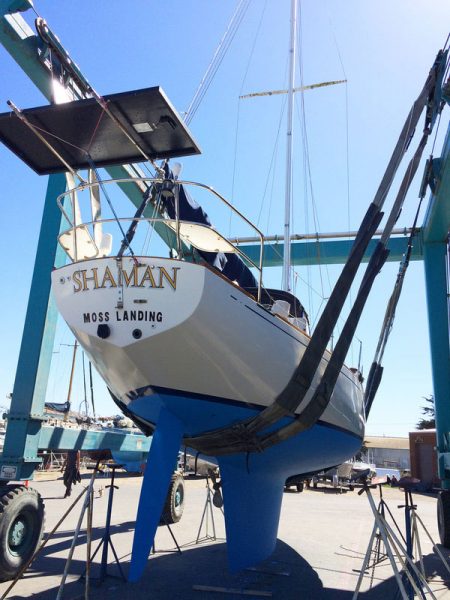
The Cal 40 was created as the combined work of three men. George Griffith, a successful racing sailor and member of the Los Angeles Yacht Club, reportedly drew the outline of a new kind of racing yacht hull on the back of a napkin, and showed it to his friend, naval architect C. William Lapworth. Griffith observed that sailing dinghies, like the International 14 class, were extremely maneuverable with their rudders hanging on their transoms, unlike the typical 40-footer of 1962, which was a full-keeled, heavy beast with the rudder swinging on the back of the keel.
Radical Ultralight Hull
Griffith’s sketch showed a flat-bottomed, radically ultralight hull, lithe and canoe-like in shape, but with a brutal, trapezoidal 6,000-pound wing stuck to the bottom. And behind this wing of a keel, way back, was a separate “spade” rudder. The design that Bill Lapworth created, at 15,000 pounds, was considered questionable, radically light and dangerously underbuilt by many of the yachting authorities, not to mention its being built out of the avant-garde new boatbuilding material of fiberglass, referred to as “extruded snot” by the esteemed L. Francis Herreshoff.
Griffith and Lapworth unsuccessfully shopped their design around to several California boatbuilders, experiencing polite rejection until they showed the plans to Jack Jensen, who agreed to build the boat on the condition that Griffith could guarantee orders for at least ten boats.
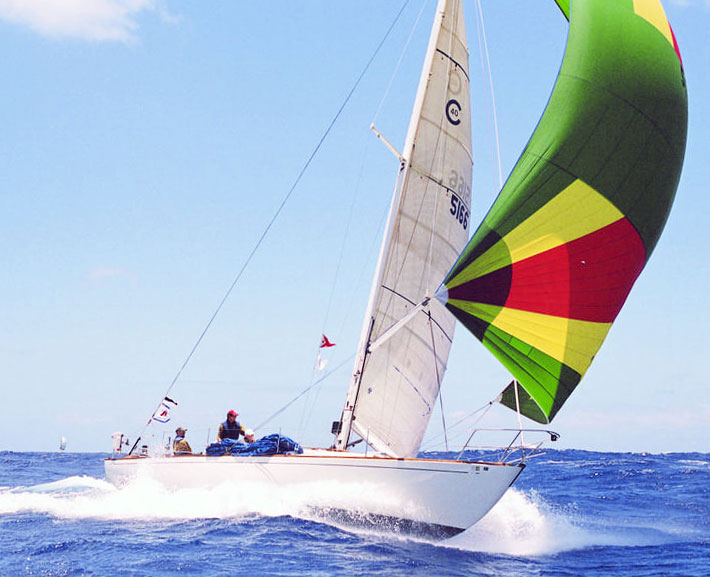
Fast forward to the present, and today the Cal 40 has attained true ‘cult’ status as a design that is sought after, restored and passed down through multiple generations of families. Try searching for Cal 40s that are for sale on Yachtworld and other sites, and you’ll likely come up empty. Folks spend multiple years and a quarter of a million dollars restoring Cal 40s and fitting them out with the latest sails, gear and electronics.
Standing the Test of Time
The Cal 40 has endured because it is not only a relatively quick downwind raceboat, but also a sweet-sailing light cruiser that, in the words of Cal 40 owner Stan Honey , “has no bad habits.” It steers beautifully under autopilot — plus it is rare to find a tiller-steered 40-ft sailboat, especially one with a light helm.
Cal 40s have twice achieved the record of being the biggest one-design fleet ever in the biennial Transpac Race, with 14 boats in 1966 and 2005. And the boat continues to rack up trophies in big ocean races too, as San Francisco Bay-based Cal 40s have continued to place well. Azure, Rodney Pimentel’s Encinal-based program, has been consistently near the top of the fleet in Bay, coastal and Pacific races. Green Buffalo and Red Head , from Richmond Yacht Club, have won at the top level. And no list of modern-era Cal 40 accomplishments is complete without mention of the husband/wife team of Stan Honey and Sally Lindsay Honey onboard Illusion .
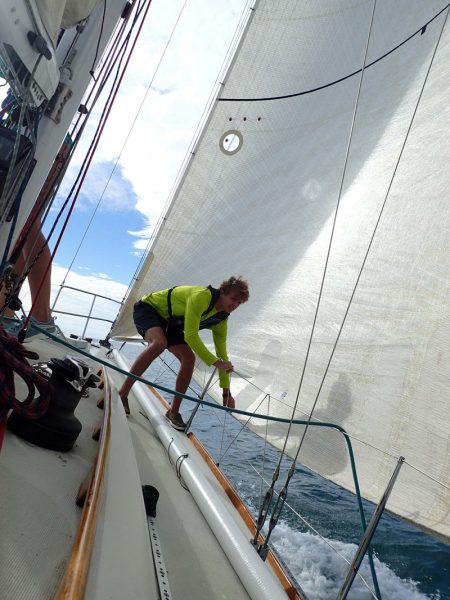
Many Cal 40 restorations are underway, or have happened recently. Fred Cook ’s complete down-to-bare-glass rebuild of Sequoia , documented in a great series of videos, is the most famous one. He’s worked with Cree Partridge, Jim Antrim, Kame Richards and other top East Bay pros to create a virtually brand-new boat.
A Swell Cal 40 Voyage
Perhaps the most well-known Cal 40 belongs to Liz Clark , who has been roaming the Pacific aboard Cal 40 #68, Swell . On what she calls, “a sailing surfer’s voyage of awakening,” Captain Clark has pushed the boundaries of solo cruising and sustainable living, all while attracting notice for her exciting adventures and sponsorship from the likes of Patagonia and North Sails. We have a copy of her excellent narrative, a book called Swell , onboard Shaman .

27 Comments
I own #120, ‘Mahalo’ and have since 2007. Yes, spent lots of $$ but she was in great shape after two Transpacs in ’03 and ’05 as ‘Flying Cloud’. She’s small by modern standards but just a blast to sail. I don’t race but I love to sail a boat well and a 40 is just a joy. She’s a great cruising boat now too.
First I would like to thank Latitude 38 for providing the magazine over the years but its especially great now when away from the water! I did the Transpac last year on Bob Hortons Cal 40 “Highlander” from Tiburon. What a great ride out there on the Pacific, I can vouch for the surfing which became competitive on the boat to see who who get the highest speed, I won by topping out at 18.9 knots on a wave at about 3-4 in the morning!, We could gauge how fast we were going by the noise of the water and how high water was spraying above the lifelines.
I like Cal 40s fine, but not the V drive most of them have.
I remember sailing with Jon Andron and his father Mort on their Cal 40 out of Santa Barbara in 1966-69. I was living aboard my boat GJOA in the SB harbor then. A fast boat ,but many “old school” sailors did not trust the FRP boats and I remember wondering if those boats would just fall apart while racing. How times changed.
We love the Cal40 here on Monterey Bay as well where we have a group of solo sailors we call “The Usual Suspects” who enjoy slugging it out on a regular basis. The Cal40 is extremely well suited for solo sailing/racing with it’s long tiller, accessible trim lines, and ability to easily steer with one’s foot while grinding in the jib after tacking. Just ask Steve Gann on his Cal40, Boomer, who (at 78 yrs young) still has enough tricks up his sleeve to teach us “youngsters” a thing or two!!!
Love Cal 40’s. Sailed in 81 and 85 on Montgomery Street in TransPac. We won it all in 85. The boat is like a freight train on rails downwind in a blow. I have many wonderful memories. I love it that Cal 40’s are still competitive 6 decades later.
How about running some of the old stories about the Cal-40. One such story that comes to mind was about Stan Honey doing the single-handed transpac in his Cal-40. Something about him beating the time of all previous Cal-40’s that had ever done the trip.
Splendid summary, thank you! It is extraordinarily impressive that almost 50 years later the Cal 40 remains an icon: a formidable racing boat that is also a sea-kindly and practical cruising boat without bad habits
It is, perhaps, worth remembering that the Cal 40 did not spring fully formed from George Griffith’s imagination onto that cocktail napkin. The same George Griffith had collaborated with the same Bill Lapworth on a prototype for the Cal 40 which was also built in Cost Mesa. This was the Lapworth 36. George Griffith took delivery of hull #1. It shared many of the same characteristics, and 71 boats were built to become a premiere one design fleet on the West Coast. It too, was radically ultralight by the standards of the day at less than 11,000 pounds. It shared the same rig and sail plan, and many of the same hull and under-body characteristics. The L-36 still had a keel hung rudder so it was the spade rudder that was the quantum leap on the Cal 40. Like the Cal 40, a well maintained Lapworth 36 remains a formidable racing boat as well as a sea-kindly and practical cruising boat without bad habits.
Full disclosure: my Father had #71 built. It is still in our family, and I expect my sons to be sailing her for many decades to come.
So additional articles must follow to describe the “cult” group of Cal 20s, 29s and other Lapworth models such as the Pearson 44, etc…. the man knew how to conceptualize racing vessels way beyond the design of the times.
What about the 40’s hot little sister the Cal 39 (pic in 2-11-18 Lec Lat, Ode to Wet Bottom Girls), or “The Other Woman” Knot A Clew.
Little? I believe the Cal 39 is both longer and heavier. Ask Saildata.com
Unfortunately, SailData.com indicates that only 107 CAL-40’s were built, but I apparently have hull #168 and I believe the above information is correct that 170 were built. Perhaps SailData.com transposed the 7 and the 0 in their count. I have come across a few other errors in their data, albeit they are a very useful source most of the time.
The Cal 39 is certainly a fine yacht, but it is fundamentally an offshore cruiser with good performance rather than a racing design that can also be cruised comfortably.
Guess I could tell a few “old” Cal 40 stories. In the ’67 Transpac (not ’66 as written in the article above), there were 14 Cal 40s on the start line. HOLIDAY TOO, #24, won class and overall, the youngest crew to do so, and a record that still stands despite MORNING LIGHT’s professional attempt at besting it. Before the 2007 Transpac, and movie of the same name, Robbie Haines of the MORNING LIGHT Disney project called me up and wanted all HOLIDAY TOO’s ’67 crew birthdates. I thought this a little strange without an explanation and refused his request. Another memory: Before the 2003 Transpac Stan Honey invited George Griffith and Bill Lapworth aboard ILLUSION for a little visit while tied up at the Griffiths’ dock in Alamitos Bay. As we sat around in the cockpit, a little contentiousness erupted. George told how Lapworth had designed the rig to be 18″ shorter, but George held out for the “tall” rig, saying Lapwoth’s “stump” would have “killed” the boat. Then the subject of who designed the Cal 40’s spade rudder, of which both Lapworth and Griffith claimed credit, arose, and was not resolved before our friendly little reunion broke up. Good times. -skip
Good to read about the history and accomplishments, past and present, of the wonderful Cal 40. My family and I have enjoyed owning Chaparral, hull number 135, for more than two decades and agree whole heartedly with the positive statements and comments about this tried and true class of great sailboats. In over 50 years on the water, Chaparral has proven the point of being an excellent racer and cruiser by performing well in off shore racing, including crewed and single handed Transpacs, as well as sailing around the world in 16 months, with her previous owner, Hans Vielhauer. Cal 40s may be old, but they certainly are good, and so much fun to sail.
Jim Quanci’s beautifully maintained Cal 40 ‘Green Buffalo’ has a few miles and many wins under her keel! I enjoyed following GB out of the gate in the 2012 SHTP, which Jim and GB won. And of course GB has also competed successfully in several Pac Cups, and many Bay races. She’s a Cal 40 worth watching!
Can anyone fill in the history of Sally and Stan’s Illusion? There was a black Cal 40 on the East Coast by that name in the early ’70s – owned by Commodore Montesano and raced by him and Bus Mosbacher. Maybe you’ve enjoyed a famous Montesano Cooler on the lawn at Larchmont. Yup – one and the same. I raced on the East Coast Illusion as a junior and have wondered if it’s the same boat. Thanks for any ideas.
Yes Sally and my Cal40 ILLUSION is the same boat as owned by Bus Mosbacher and Vince Monte-Sano. We sailed ILLUSION around to the East Coast to do the Bermuda Race in 2020 which was cancelled. Our fallback was two terrific summers cruising in Maine. We’ll be racing ILLUSION in the upcoming Newport Bermuda Race in June 2022. Interestingly ILLUSION’s first Bermuda Race was in 1966 raced by Mosbacher and Monte-Sano in which she came second to the Cal40 Thunderbird. The seven Cal40’s swept the results that year.
I am the keeper of hull 147 (I think) under the name EnFin, located on the Great Lakes. Although her specific history has gaps, it’s believed she’s lived in the fresh water of Lake Ontario for all of her life. In my opinion the Cal-40 has the best cockpit and is…. sparse down below. The cramped galley and curved floor can be difficult to get used to, but in a >15kn beam reach she makes it tough for boats far lighter and newer to keep up.
It is the same ILLUSION as owned by Mosbacher and Montesano. Hull number 57. She used to be black. There are half hulls of her in the NYYC Model Room and in Larchmont YC. She used to have sail number 1700, probably because Weatherly, the 12 that Mosbacher sailed in the Cup had sail number 17.
Thanks Stan, that connects the dots and brings back lots of happy memories. Glad to know you’re continuing the fun. Good luck in June. TK
I crewed on an L40 owned by Dr. Ed DuBois out of Marina del Rey back In 1968 and 1969. It was a lot of fun even tough we weren’t very competitive. I’d love to know if that boat is still around. I have no remembrance of the name or numbers of the boat. Ryan Anderson
Was the Dubois L40 also named Duboius? I was best friends with Larry Dubois back then.
I remember racing against Laughing Sally in Puerto Rico early 1970s. Dick Doran was the helmsman. It was the most dominant and professional boat during those days. In 1970 won Antigua.
I’m the current care taker of 1970 built Cal-40 Jubilee. Almost done with a full refit here on the Gulfcoast near the Florida Alabama line. I was really enjoying the ride until starting on the long journey of redoing outside and in. Everything except the engine and transmission have been changed out. About to rig and step the mast soon. Hope to have her ready to go fall of ‘23.
Take good care! I learned to sail on Jubalee in the 80’s in Houston. She’s special. I’ve heard a photo of her was in the Charleston yacht club for a while.
There used to be a small plaque or something on the bulk head commentating a SORC record she set.
I have (should I say am trustee of? lol) a Cal-40 that is apparently Hull# 168, formerly named ‘Callalou’ or ‘Callaloo’, and now named ‘Innisfree’ likely after the Irish poet Yeats’ poem of the same name. I’ll keep her name as is. She needs some deferred maintenance caught up and rehabilitation. The teak is in need of cleaning and oiling and the cockpit backboards will most likely need replacing. The power plant is not original. She has a Westerbeke W-33 now, which was derived from a Perkins block; some parts are interchangeable. The engine starts and runs fine now with a new waterpump. I am eager to get her sailing again as I think she has awesome lines, not to mention all of the Cal-40 history and accolades I am learning more about. Any help with photographs of original cabin layouts, maintenance issues to look for, etc., will be greatly appreciated. Thank you in advance.
Leave a Comment Cancel Reply
Notify me via e-mail if anyone answers my comment.
Messages to the Neighbors Hoisting the Signal Flags "When you live in Sacramento like I do and miss sailing on San Francisco Bay with your buddies (like I do), what else was I supposed to do? I dug deep into my gear box…"
Sponsored Post Westwind Boat Detailing Washing, waxing, varnishing. Serving the entire Bay Area for more than 30 years. “I have never seen the teak look so good."
Commentary Following the Rules, Until You Don’t Today, New Zealand went from its “Level 4” lockdown — the highest, most strict tier — down to “Level 3.” More businesses will be allowed to open, and more activities will be allowed.
Subscribe to the Magazine Take a Break from Junk Mail with Latitude 38 “You are awesome and remind me how much MORE I like/crave/need the print version. I hope you don’t suspend it.”
Great choice! Your favorites are temporarily saved for this session. Sign in to save them permanently, access them on any device, and receive relevant alerts.
- Sailboat Guide
Caliber 40 Lrc
Caliber 40 Lrc is a 40 ′ 10 ″ / 12.5 m monohull sailboat designed by Michael McCreary and built by Caliber Yachts starting in 1995.

Rig and Sails
Auxilary power, accomodations, calculations.
The theoretical maximum speed that a displacement hull can move efficiently through the water is determined by it's waterline length and displacement. It may be unable to reach this speed if the boat is underpowered or heavily loaded, though it may exceed this speed given enough power. Read more.
Classic hull speed formula:
Hull Speed = 1.34 x √LWL
Max Speed/Length ratio = 8.26 ÷ Displacement/Length ratio .311 Hull Speed = Max Speed/Length ratio x √LWL
Sail Area / Displacement Ratio
A measure of the power of the sails relative to the weight of the boat. The higher the number, the higher the performance, but the harder the boat will be to handle. This ratio is a "non-dimensional" value that facilitates comparisons between boats of different types and sizes. Read more.
SA/D = SA ÷ (D ÷ 64) 2/3
- SA : Sail area in square feet, derived by adding the mainsail area to 100% of the foretriangle area (the lateral area above the deck between the mast and the forestay).
- D : Displacement in pounds.
Ballast / Displacement Ratio
A measure of the stability of a boat's hull that suggests how well a monohull will stand up to its sails. The ballast displacement ratio indicates how much of the weight of a boat is placed for maximum stability against capsizing and is an indicator of stiffness and resistance to capsize.
Ballast / Displacement * 100
Displacement / Length Ratio
A measure of the weight of the boat relative to it's length at the waterline. The higher a boat’s D/L ratio, the more easily it will carry a load and the more comfortable its motion will be. The lower a boat's ratio is, the less power it takes to drive the boat to its nominal hull speed or beyond. Read more.
D/L = (D ÷ 2240) ÷ (0.01 x LWL)³
- D: Displacement of the boat in pounds.
- LWL: Waterline length in feet
Comfort Ratio
This ratio assess how quickly and abruptly a boat’s hull reacts to waves in a significant seaway, these being the elements of a boat’s motion most likely to cause seasickness. Read more.
Comfort ratio = D ÷ (.65 x (.7 LWL + .3 LOA) x Beam 1.33 )
- D: Displacement of the boat in pounds
- LOA: Length overall in feet
- Beam: Width of boat at the widest point in feet
Capsize Screening Formula
This formula attempts to indicate whether a given boat might be too wide and light to readily right itself after being overturned in extreme conditions. Read more.
CSV = Beam ÷ ³√(D / 64)
Original information indicates 179 gal / 677.6 liter water tank. Current brochures show 165 gal / 624.6 liter water tank.
Embed this page on your own website by copying and pasting this code.
- About Sailboat Guide
©2024 Sea Time Tech, LLC
This site is protected by reCAPTCHA and the Google Privacy Policy and Terms of Service apply.

IMAGES
VIDEO
COMMENTS
40 to 50 indicates a heavy bluewater boat; over 50 indicates an extremely heavy bluewater boat. Comfort ratio = D ÷ (.65 x (.7 LWL + .3 LOA) x Beam^1.33), where displacement is expressed in pounds, and length is expressed in feet. Capsize Screening Formula (CSF): Designed to determine if a boat has blue water capability.
The rig dimensions above are from the 1963 sail plan drawing. Current class rules (2005) allow a max of: I - 46.7'. J - 15.3'. P - 40.1'. E - 17.55'. The accolades for this particular boat are many. Certainly one of the most influential designs and successful racing boats ever. With 160 built, it was also a commercial success for Jensen Marine.
Blue Water Surf Value Rank (BWSVR) 1551. Capsize Comfort Value Rank (CCVR)
Sailboats 36-40ft; used_sailboats; Caliber 40 LRC ... The Caliber 40 LRC has a projected cruising range of 1,484 miles when motoring at 7 knots with a Yanmar 50 diesel running at 2,500 rpm. George is tightlipped about information he considers proprietary—the company's gross sales, annual production, and number of employees or dealers, for ...
Blue Water Surf Value Rank (BWSVR) 1551
The Caliber 40 LRC Sailboat. The Caliber 40 LRC, a robust long-range cruiser sailboat, is a creation from the drawing board of Michael McCreary, an American designer. This sailboat exemplifies a blend of endurance and comfort for long-distance sailing. It is built by Caliber Yachts, a company established and located in Clearwater, Florida.
The Caliber 40 is a 40.92ft cutter designed by Michael McCreary and built in fiberglass by Caliber Yachts (USA) since 1992. The Caliber 40 is a moderate weight sailboat which is under powered. It is very stable / stiff and has a good righting capability if capsized. It is best suited as a bluewater cruising boat. The fuel capacity is average.
Thunderbird, a Cal 40 owned by IBM president T. Vincent Learson, took first in fleet over 167 boats in the 1966 Bermuda Race. Because this was the first computer-scored Bermuda Race, Learson got a lot of gaff about the IBM computer that had declared him the winner—and about beating out his boss. Thomas J. Watson, IBM's chairman of the board ...
The Caliber 40 lrc is a 40.92ft cutter designed by Michael McCreary and built in fiberglass by Caliber Yachts (USA) since 1995. The Caliber 40 lrc is a moderate weight sailboat which is slightly under powered. It is very stable / stiff and has a good righting capability if capsized.
Caliber 40 LRC preowned sailboats for sale by owner. Caliber 40 LRC used sailboats for sale by owner. Home. Register & Post. View All Sailboats. Search. Avoid Fraud. ... 40' Nordic Yachts Nordic40 North Kingstown, Rhode Island Asking $100,000. 42' Pearson 424 Ketch Worton Creek, Maryland Asking $72,000.
It is unclear if the original 40 was produced alongside the 40 LRC or was discontinued in favor of the LRC. A total of 130 of the 40 LRCs were produced. Caliber 40 sailboat photo by Tarn Kelsey. Systems. The engine and drive train in both models were similarly sized (50 to 55-hp) Yanmar engines with Kanzaki mechanical transmissions.
Sailboat data, rig dimensions and recommended sail areas for Caliber 40 LRC sailboat. Tech info about rigging, halyards, sheets, mainsail covers and more. Sailboat Data directory for over 8,000 sailboat designs and manufacturers. Direct access to halyards lengths, recommended sail areas, mainsail cover styles, standing rigging fittings, and ...
The Classic 1960s Ocean Racing Legend. The Cal 40 is a roughly 39-ft 4-in fiberglass production racing and cruising sailboat, of which about 155 were built in Costa Mesa, California, starting in 1963. The first mass-produced sailboat that was capable of sustained surfing on waves, the Cal 40 dominated ocean racing during the 1960s like no other design before or since.
Find Caliber 40 Lrc boats for sale in your area & across the world on YachtWorld. Offering the best selection of Caliber boats to choose from.
Caliber Yachts (USA) www.caliberyacht.com. Founded by George and Michael McCreary and located in Clearwater Florida USA. The first model was the CALIBER 28. This was followed by the 30, 33, 35, 40 and 47 all Micheal McCreary designs. Years in Business: 1980 - present. Sailboats Built By Caliber Yachts (USA) (Dates indicate when boat was first ...
The higher a boat's D/L ratio, the more easily it will carry a load and the more comfortable its motion will be. The lower a boat's ratio is, the less power it takes to drive the boat to its nominal hull speed or beyond. Read more. Formula. D/L = (D ÷ 2240) ÷ (0.01 x LWL)³ D: Displacement of the boat in pounds. LWL: Waterline length in feet
Currently, there are several used Caliber 40s and 40 LRCs listed on Yachtworld. Selling price on the 40s moves between $143,000 and $159,000 but the more recent LRC versions are listing at $75,000 to 100,000 higher. View a list of Caliber Yachts for sale. LOA: 40' 11". LWL: 32' 6".
Find Caliber 40 boats for sale in your area & across the world on YachtWorld. Offering the best selection of Caliber boats to choose from. ... Oaksmith Yachts | Chelan, Washington. 2006 Correct Craft 226 LE. US$34,995. Union Marine (Issaquah Store) | Issaquah, Washington. 2023 Nautique Super Air Nautique G23. Request price.
Used Caliber 40 LRCs currently on the market range from a 1996 model offered at $194,900 to a 2003 model offered at $249,900. Reported sales over the last six months range from $143,000 for a 1993 model to $265,000 for a 2007 model. There are plenty of less expensive used boats in this size and age range, but there may be no less expensive ...
The Caliber 40 is a recreational keelboat, built predominantly of fiberglass, with teak wood trim. It has a cutter rig, with anodized aluminum spars, a bowsprit, a raked stem and reverse transom, with a swing-down swimming ladder and hand-held shower. It features a skeg -mounted rudder controlled by a wheel and a fixed fin keel.
The Caliber 40 has a fully encapsulated, elongated fin keel that has an iron and concrete ballast of 9,500 pounds. Her ballast to displacement ratio is a very respectable 44% which is good to find on a boat intended for bluewater use. The rudder is skeg hung for protection and tracking and her waterline is just over 32 feet.
The Cal 40 is a racing keelboat, built predominantly of fiberglass, with wood trim. It has a masthead sloop rig; a spooned, raked stem; a raised counter, transom; an internally mounted spade-type rudder controlled by a tiller and a fixed fin keel. It displaces 15,000 lb (6,804 kg) and carries 6,000 lb (2,722 kg) of lead ballast.
Find more information and images about the boat and contact the seller or search more boats for sale on YachtWorld. ... The Caliber 40 LRC is purposefully crafted for transoceanic voyages, meticulously outfitted by its owners to fulfill precisely that purpose. Presenting SV UnRuly Julie, a vessel primed for exploration, awaiting her next ...